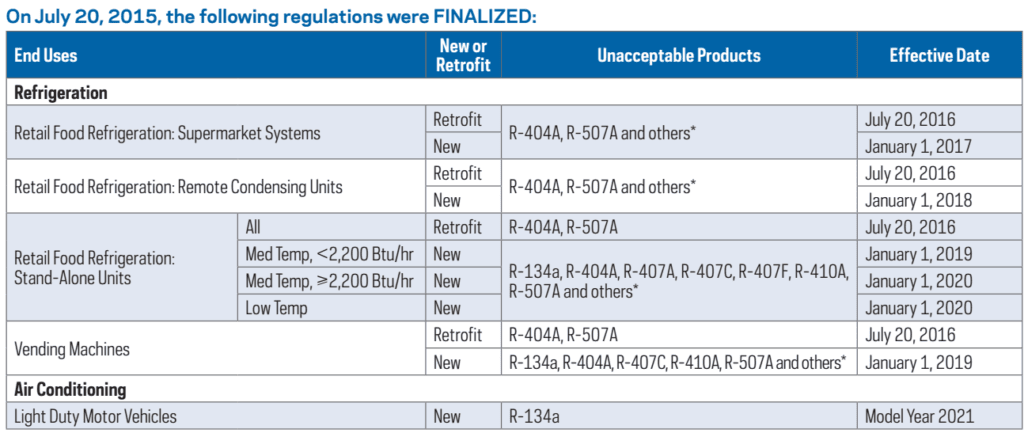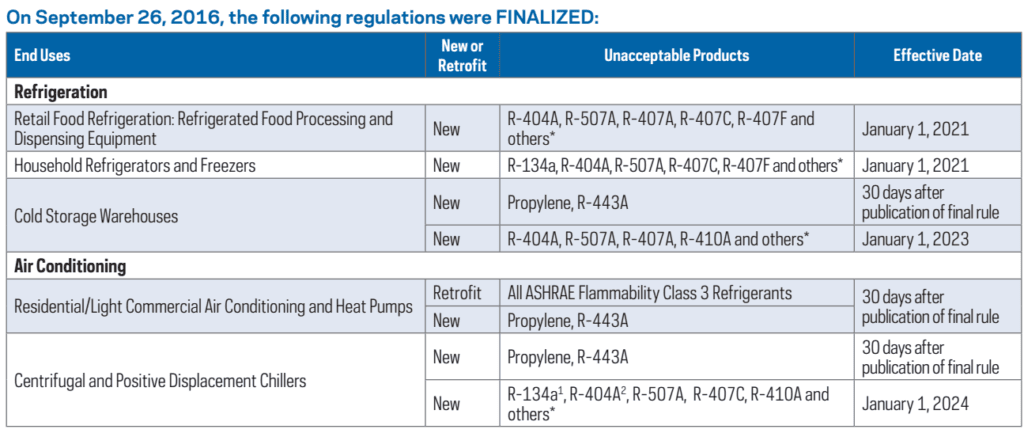Hello folks, this is an old article from 2016. Please check out our update on the R-134a phase out date. Thanks for reading!
The answer is yes… and no. This one is kind of tricky. R-134a is not going out the same way the CFCs and HCFCs went. (R-12 & R-22.) These types of refrigerants were both phased out in accordance to the Montreal Protocol in the 1990s and most recently in 2010. It was found that the Chlorine that these refrigerants contained were tearing a hole in the O-Zone layer if they were vented into the atmosphere. When their phase out started two things happened:
- The first was that no new machines could be manufactured using the CFC or HCFC refrigerants. All new machines had to be switched over to the HFC refrigerants. This is where R-134a and R-410A got their start.
- The second thing that happened was that there was a mandatory reduction in supply mandated by the federal government. Every year that passed the government cut the amount of CFCs and HCFCs allowed into the country. Along with the imports the means of production was cut as well. Companies were only allowed to produce so much per year of these Chlorine containing chemicals. As time wore on production all but stopped of CFCs. We are still waiting for the final deadline on the HCFCs such as R-22 but we are only a few short years away from the 2020 deadline.
So, What’s the Scoop on R-134a?
Alright, so now that we have some background on how the past phase-outs have worked let’s take a look at what is happening with R-134a. It was announced in July of 2015 that the Environmental Protection Agency would be phasing out certain HFC refrigerants such as R-404A. In this list of refrigerants being phased out R-134a was mentioned. Along with the announcement in July of 2015 the EPA also made another announcement in September of this year.
Instead of trying to explain everything in text I figured it would be easier to review in a table or picture. When you are reviewing these pictures keep an eye out for the R-134a refrigerant under the ‘Unacceptable Products’ column. I pulled these tables directly from Chemour’s website. All credit goes to them for compiling the data. (Click here for source.)


Did you find the big change? Don’t worry. I’ll go over it as well. Towards the bottom of the first picture you’ll see the change that everyone is asking about. As of the year 2020, or 2021 model year, light duty vehicle manufacturers will no longer be able to use R-134a in their new automobiles. The mandate does not say what they have to use instead but there are very little choices to choose from. Most manufacturers will end up going with the HFO refrigerant known as 1234YF. This new refrigerant runs very high in price at about $700 per ten pound cylinder compared to the $120 for a thirty pound cylinder of 134a.
So, to answer your question the phase out date for R-134a is set for 2020. However, with that being said there is one important thing to point out. Unlike with the CFCs and HCFCs phase-outs of the past the R-134a phase-out is not seeing a mandatory reduction in imports or production. What this means is that supply of R-134a should more or less remain the same but the demand is going to start shrinking and shrinking with each passing year. When we go above and beyond the year 2020 I could see the price of R-134a plummeting. That is unless the Chinese tariffs get approved. (Click here to read about the tariffs.)
Why is 134a Being Phased Out?
Unlike the CFCs and HCFCs of the past 134a does not contain Chlorine and does not damage the O-Zone layer. The worry with 134a is it’s Global Warming Potential, or GWP. GWP is a relative measure of how much heat a greenhouse gas traps in the atmosphere. It compares the amount of heat trapped by a certain mass of the gas in question to the amount of heat trapped by a similar mass of carbon dioxide. A GWP is calculated over a specific time interval, commonly 20, 100 or 500 years. GWP is expressed as a factor of carbon dioxide (whose GWP is standardized to 1). (Source from Wikipedia.)
As stated above the GWP on Carbon Dioxide is 1. The GWP on 134a refrigerant is 1,430 times that of Carbon Dioxide. So, when 134a is vented into the atmosphere it releases a greenhouse gas that is 1,400 times stronger than the standard Carbon Dioxide. Beginning to see the problem here?
Conclusion
So ladies and gentlemen in conclusion R-134a is being phased out across all light duty vehicles in the year 2020 or the 2021 model year. The thing to keep in mind though is that while the applications are being phased out the refrigerant itself is not. It very well may be that the government’s strategy on this is to phase out 134a by starvation. If there are no more applications that use 134a in fifteen years then why even bother phasing it out in the first place?